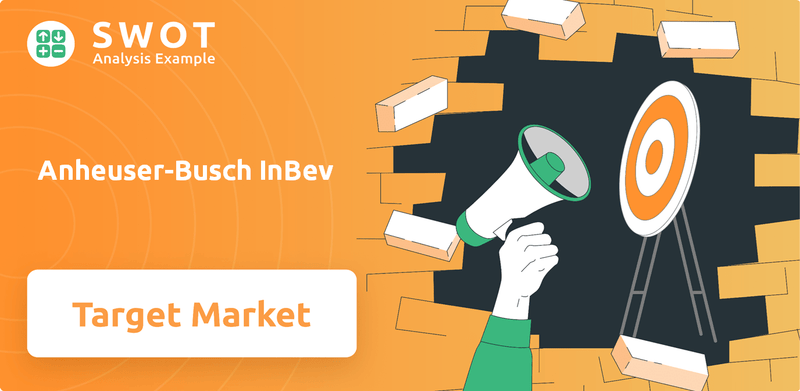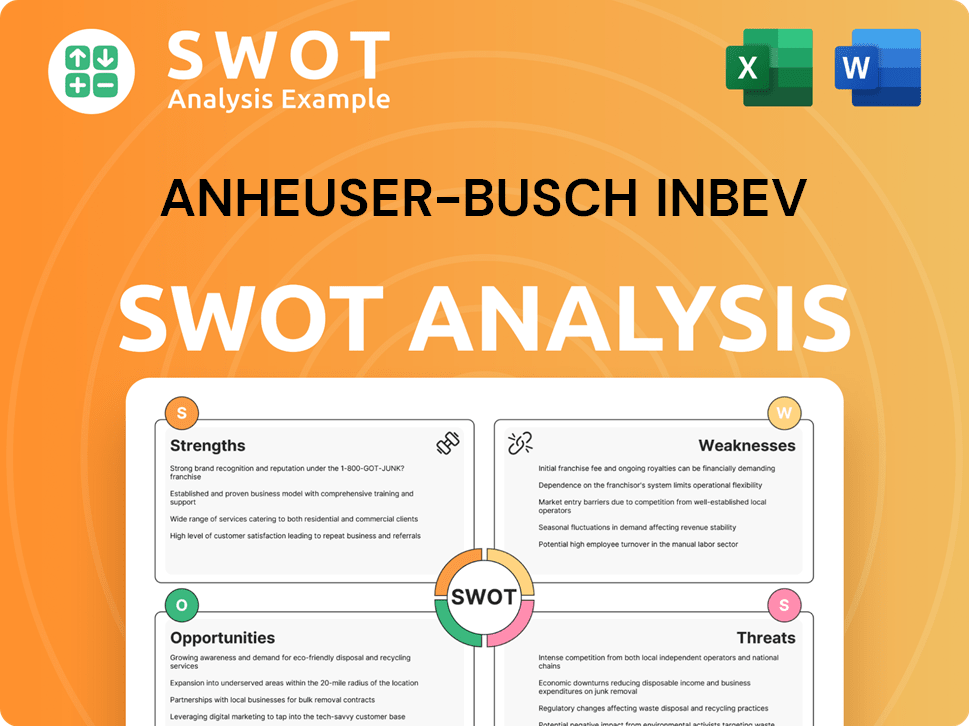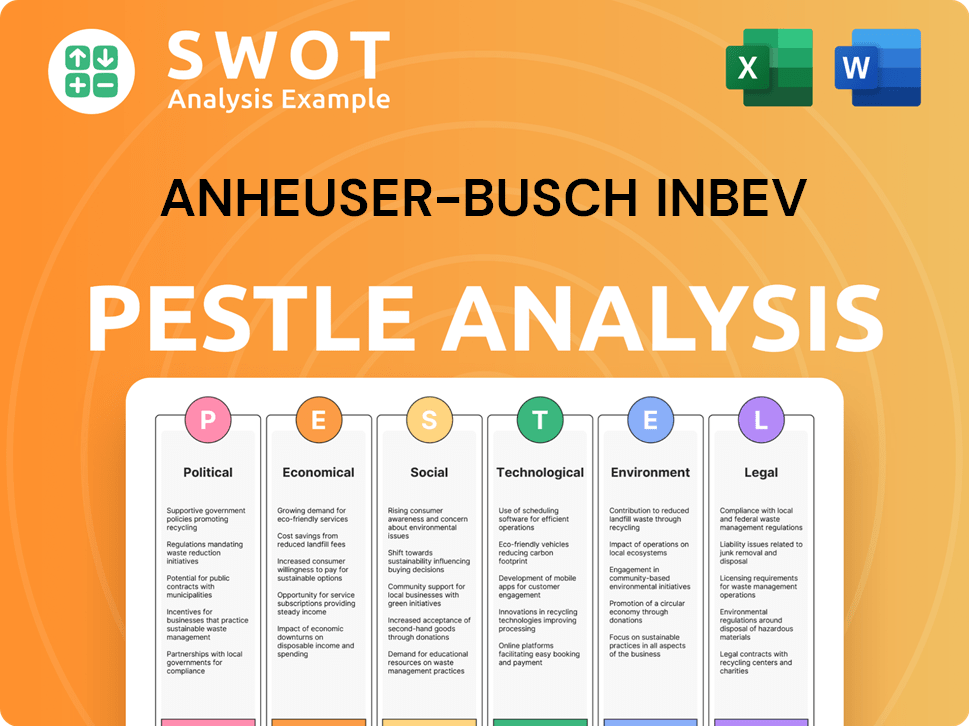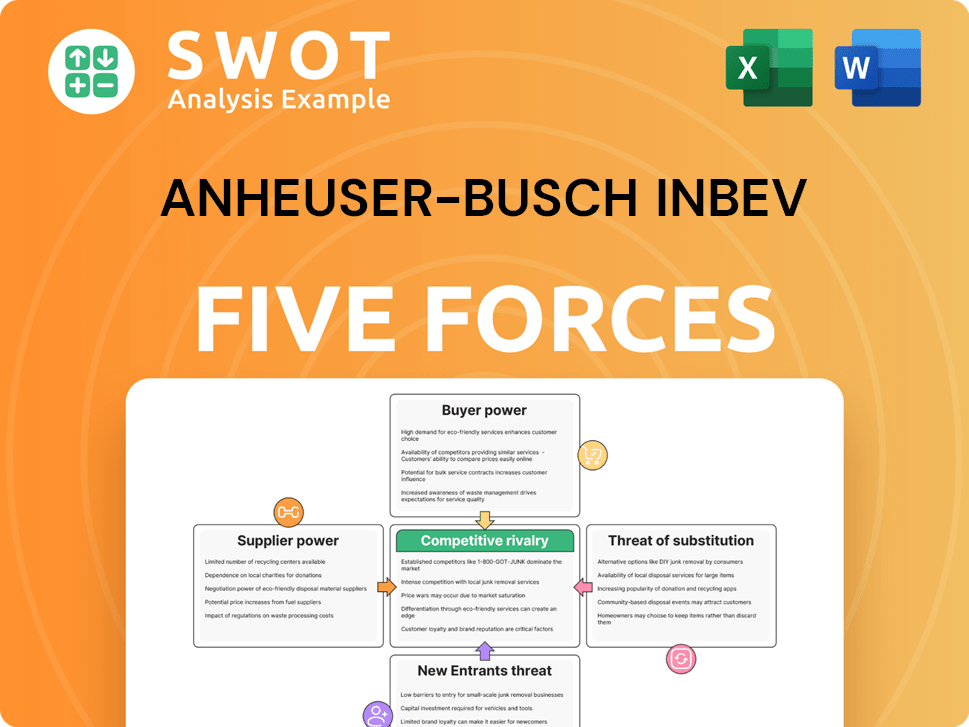Anheuser-Busch InBev Bundle
Can You Define Anheuser-Busch InBev's Ideal Customer?
Navigating the complex world of global markets requires a deep understanding of who you're selling to, and for Anheuser-Busch InBev (AB InBev), this is a critical factor for success. The company's journey, marked by strategic mergers and acquisitions, showcases the importance of adapting to evolving Anheuser-Busch InBev SWOT Analysis and shifting consumer preferences. The 'Bud Light controversy' of 2023 served as a stark reminder: knowing your customer demographics is non-negotiable.

This analysis delves into AB InBev's intricate market segmentation strategy, exploring the consumer profile that drives its global dominance. We'll uncover the target market, examining factors like age, gender, income, and lifestyle to understand how AB InBev strategically positions its diverse portfolio. By understanding the 'who,' 'where,' and 'why' behind AB InBev's customer base, we gain valuable insights into the company's ability to thrive in a dynamic marketplace.
Who Are Anheuser-Busch InBev’s Main Customers?
Understanding the customer demographics and target market of AB InBev is crucial for assessing its market position and growth potential. The company operates primarily in the Business-to-Consumer (B2C) market, serving a diverse global customer base. Its extensive portfolio includes over 500 beer and other beverage brands, catering to various age groups, income levels, and lifestyles.
AB InBev's strategy in 2024 and 2025 focuses on 'Core Superiority' and 'Premiumization'. Core mainstream beer, representing around 50% of its FY24 revenue, saw low-single digit revenue growth in 60% of its markets. Above-core beer, including brands like Corona and Michelob ULTRA, accounted for 35% of FY24 revenue, with low-single digit growth. This strategy reflects a nuanced approach to market segmentation, targeting different consumer preferences and occasions.
The company is also significantly investing in 'Occasions Development' and 'Beyond Beer' products. This includes non-alcoholic beers and other beverages, responding to changing consumer preferences. In FY24, the Beyond Beer segment represented 2% of revenue, while non-alcoholic beer saw a low-twenties revenue increase, indicating a shift towards healthier and more diverse options. To delve deeper into the company's strategies, you can explore a detailed analysis of AB InBev's market strategies.
AB InBev's core segments include mainstream beer consumers, premium beer drinkers, and those interested in beyond-beer options. Mainstream beer represents a significant portion of the revenue, while premium brands like Corona and Michelob ULTRA drive growth. The company is also targeting consumers seeking non-alcoholic and alternative beverage choices.
The target market spans various age groups, with a growing focus on younger generations like Gen Z and Millennials. These groups are digitally native and more socially conscious. AB InBev caters to diverse lifestyles, from casual beer drinkers to those seeking premium or non-alcoholic alternatives.
AB InBev operates globally, with a strong presence in North America, Latin America, Europe, and Asia-Pacific. Growth strategies vary by region, with a focus on market-specific preferences and trends. Corona, for instance, saw strong growth outside of Mexico in FY24.
The company targets a broad range of income levels, offering products from value-priced beers to premium brands. Consumption patterns are influenced by factors like occasions, lifestyle, and regional preferences. The growth in non-alcoholic beer demonstrates a shift towards health-conscious consumption.
AB InBev is adapting to evolving consumer preferences by expanding its product portfolio and focusing on premiumization and non-alcoholic options. The company emphasizes digital platforms like BEES to reach retailers and distributors effectively.
- Premiumization: Driving growth with brands like Corona and Michelob ULTRA.
- Beyond Beer: Expanding into categories like hard seltzers and ready-to-drink beverages.
- Non-Alcoholic Options: Increasing the availability and appeal of non-alcoholic beers like Corona Cero, which achieved triple-digit volume growth in FY24.
- Digital Platforms: Utilizing platforms like BEES to enhance distribution and reach.
Anheuser-Busch InBev SWOT Analysis
- Complete SWOT Breakdown
- Fully Customizable
- Editable in Excel & Word
- Professional Formatting
- Investor-Ready Format

What Do Anheuser-Busch InBev’s Customers Want?
Understanding the customer needs and preferences is crucial for the success of any company, and for AB InBev, this involves a deep dive into the evolving tastes and behaviors of its diverse consumer base. The company's approach is multifaceted, encompassing product innovation, strategic marketing, and a commitment to sustainability. This allows AB InBev to stay relevant and competitive in the dynamic beverage market.
Anheuser-Busch InBev's customers are driven by a variety of needs, motivations, and preferences that go beyond simply quenching their thirst. Consumers are increasingly seeking healthier and more diverse options, which has led the company to expand its offerings to meet these demands. This includes a focus on non-alcoholic beverages and products that cater to dietary preferences.
The company also recognizes that purchasing behaviors are influenced by factors such as convenience, variety, and flavor profiles. To address these preferences, AB InBev has developed a 'Beyond Beer' portfolio that includes ready-to-drink (RTDs) and other alternative beverages. Loyalty is also influenced by sustainability and social responsibility, with consumers seeking brands that prioritize environmental efforts.
Consumers are increasingly seeking balanced choices, leading to a demand for low-carb, organic, sugar-free, gluten-free, and no-alcohol brands. AB InBev has responded by expanding its non-alcoholic beer offerings.
The non-alcoholic beer offerings saw a low-twenties revenue increase in FY24. Corona Cero is leading with triple-digit volume growth. This addresses the growing preference for healthier or more diverse options.
Purchasing behaviors are influenced by convenience and variety, which AB InBev addresses through its 'Beyond Beer' portfolio of ready-to-drinks (RTDs), canned cocktails, and other alternative beverages.
The 'Beyond Beer' segment generated $1.5 billion in revenue in 2024. This shows the importance of catering to diverse consumer preferences.
Loyalty factors are also influenced by sustainability and social responsibility, with consumers seeking brands that prioritize environmental efforts. AB InBev has set ambitious sustainability goals.
AB InBev aims to use 100% of its purchased electricity from renewable sources by 2025 and reduce CO2 emissions across its value chain by 25% by 2025. These goals are crucial for brand image.
AB InBev tailors its marketing, product features, and customer experiences to specific segments. For example, in the U.S., Michelob ULTRA's growth has been led by wellness campaigns, while Bud Light has aimed to regain market share with inclusive messaging.
- Budweiser's marketing strategy in 2025 focuses on digital platforms, sustainability, and enhancing brand relevance to connect with younger audiences like Gen Z and Millennials.
- The company utilizes data and technology, including its BEES and DTC digital platforms, to promote moderation and responsible drinking.
- Understanding the Owners & Shareholders of Anheuser-Busch InBev provides insights into the company's strategic direction.
- These strategies help AB InBev effectively reach its target market by addressing their unique needs and preferences.
Anheuser-Busch InBev PESTLE Analysis
- Covers All 6 PESTLE Categories
- No Research Needed – Save Hours of Work
- Built by Experts, Trusted by Consultants
- Instant Download, Ready to Use
- 100% Editable, Fully Customizable

Where does Anheuser-Busch InBev operate?
Anheuser-Busch InBev (AB InBev) has a substantial global presence, operating in almost 50 countries and marketing its diverse portfolio of over 500 beer brands in more than 150 countries. This widespread geographical reach is a key element of its strategy for reaching its target market. AB InBev's ability to adapt to diverse markets is crucial for its success.
The company's market presence is balanced across both developed and developing markets, allowing it to capture a wide range of consumer profiles. This strategic distribution helps AB InBev manage risk and capitalize on growth opportunities globally. AB InBev's approach involves tailoring its offerings and marketing campaigns to suit local tastes and preferences, thus enhancing its appeal to a diverse customer base.
AB InBev's major markets include the U.S., Brazil, and Belgium, where it holds a strong market share. In FY24, the company saw revenue growth in 75% of its markets. For example, South Africa and Colombia experienced high-single digit revenue growth in their mainstream beer portfolios. In Brazil, Budweiser led the industry in volume share gains, with volumes increasing by nearly 50%. While overall volume performance in FY24 was affected by weaker consumer environments in China and Argentina, global beer volumes grew by 0.9% when excluding these two countries. This demonstrates the company's resilience and ability to perform well in various regions.
AB InBev tailors its marketing to suit local preferences. In Mexico, Corona is promoted as a premium beer, while in the U.S., Budweiser emphasizes its heritage. This approach helps AB InBev connect with consumers in different regions.
The company actively seeks global expansion, particularly in Asia, recognizing the potential in emerging economies. This strategy focuses on adapting product offerings and marketing to local tastes, thus expanding its consumer base.
AB InBev's digital B2B platform, BEES, was live in 28 markets as of December 2024, capturing 75% of its revenues through these platforms. This digital strategy enhances its market presence and improves efficiency.
The DTC omnichannel ecosystem, which includes Zé Delivery, TaDa Delivery, and PerfectDraft, generated $1.4 billion in revenue in 2024 across 21 markets. These channels provide a direct link to consumers, boosting sales.
AB InBev forms partnerships with local distributors and retailers to enhance its market presence. These collaborations are crucial for reaching the target market and ensuring product availability.
The company's strategy involves adapting product offerings and marketing campaigns to local tastes and preferences, and forming partnerships with local distributors and retailers to enhance market presence. For more details on the company's overall approach, see Growth Strategy of Anheuser-Busch InBev.
Anheuser-Busch InBev Business Model Canvas
- Complete 9-Block Business Model Canvas
- Effortlessly Communicate Your Business Strategy
- Investor-Ready BMC Format
- 100% Editable and Customizable
- Clear and Structured Layout

How Does Anheuser-Busch InBev Win & Keep Customers?
AB InBev's customer acquisition and retention strategies are designed to engage a diverse customer demographics, leveraging both traditional and digital channels. The company invested a substantial $7.2 billion in sales and marketing globally in 2024 to strengthen its brands and build equity. These strategies are critical for maintaining and growing its market share in a competitive industry. The company's approach involves a mix of marketing, sales tactics, and innovative programs to attract and retain customers.
Marketing efforts include extensive digital marketing, social media engagement, and influencer partnerships, particularly targeting younger demographics like Gen Z and Millennials. Sponsorships and event marketing, such as the FIFA World Cup, are also key components. AB InBev also uses customer data and CRM systems for targeted campaigns and personalized messaging. These strategies are crucial for reaching different segments within its target market.
Retention strategies include addressing evolving consumer preferences, such as the demand for non-alcoholic options and healthier choices, and emphasizing sustainability initiatives. AB InBev is also committed to investing at least $1 billion USD by the end of 2025 in social marketing campaigns to promote responsible drinking. For a deeper dive into the company's marketing approach, consider exploring the Marketing Strategy of Anheuser-Busch InBev.
AB InBev uses digital marketing and social media platforms like Instagram, TikTok, and Twitter to connect with younger audiences. This includes visually appealing and interactive content designed to increase engagement. The aim is to build brand awareness and foster customer loyalty through these channels, especially among the consumer profile.
Influencer marketing is a key strategy for AB InBev, with collaborations helping to reach wider audiences and tap into new markets. The 'Club Premium' campaign in Ecuador, for example, increased market share by 34% in the premium segment through influencer marketing. This approach helps to effectively target different segments via market segmentation.
Sponsorships of major sports events and music festivals are used to increase brand visibility and connect with consumers. Budweiser's sponsorship of the FIFA World Cup is a prime example. In India, AB InBev focuses on owned festivals and experiential marketing due to advertising restrictions.
The B2B e-commerce platform, BEES, has been a key driver, with its gross merchandise value (GMV) growing by 57% to $2.5 billion in 2024. Over 36 million orders were processed through this platform, which facilitates direct engagement with over six million customers globally.
DTC initiatives, including Zé Delivery, TaDa Delivery, and PerfectDraft, generated $1.4 billion in revenue in 2024. Over 76 million orders were processed through these platforms. This strategy allows AB InBev to directly engage with consumers and gather valuable data.
AB InBev addresses evolving consumer preferences by offering non-alcoholic options and emphasizing sustainability. The company's commitment to these areas helps retain customers who value these aspects of their products. This also helps to appeal to a broader AB InBev target audience analysis.
Anheuser-Busch InBev Porter's Five Forces Analysis
- Covers All 5 Competitive Forces in Detail
- Structured for Consultants, Students, and Founders
- 100% Editable in Microsoft Word & Excel
- Instant Digital Download – Use Immediately
- Compatible with Mac & PC – Fully Unlocked

Related Blogs
- What are Mission Vision & Core Values of Anheuser-Busch InBev Company?
- What is Competitive Landscape of Anheuser-Busch InBev Company?
- What is Growth Strategy and Future Prospects of Anheuser-Busch InBev Company?
- How Does Anheuser-Busch InBev Company Work?
- What is Sales and Marketing Strategy of Anheuser-Busch InBev Company?
- What is Brief History of Anheuser-Busch InBev Company?
- Who Owns Anheuser-Busch InBev Company?
Disclaimer
All information, articles, and product details provided on this website are for general informational and educational purposes only. We do not claim any ownership over, nor do we intend to infringe upon, any trademarks, copyrights, logos, brand names, or other intellectual property mentioned or depicted on this site. Such intellectual property remains the property of its respective owners, and any references here are made solely for identification or informational purposes, without implying any affiliation, endorsement, or partnership.
We make no representations or warranties, express or implied, regarding the accuracy, completeness, or suitability of any content or products presented. Nothing on this website should be construed as legal, tax, investment, financial, medical, or other professional advice. In addition, no part of this site—including articles or product references—constitutes a solicitation, recommendation, endorsement, advertisement, or offer to buy or sell any securities, franchises, or other financial instruments, particularly in jurisdictions where such activity would be unlawful.
All content is of a general nature and may not address the specific circumstances of any individual or entity. It is not a substitute for professional advice or services. Any actions you take based on the information provided here are strictly at your own risk. You accept full responsibility for any decisions or outcomes arising from your use of this website and agree to release us from any liability in connection with your use of, or reliance upon, the content or products found herein.